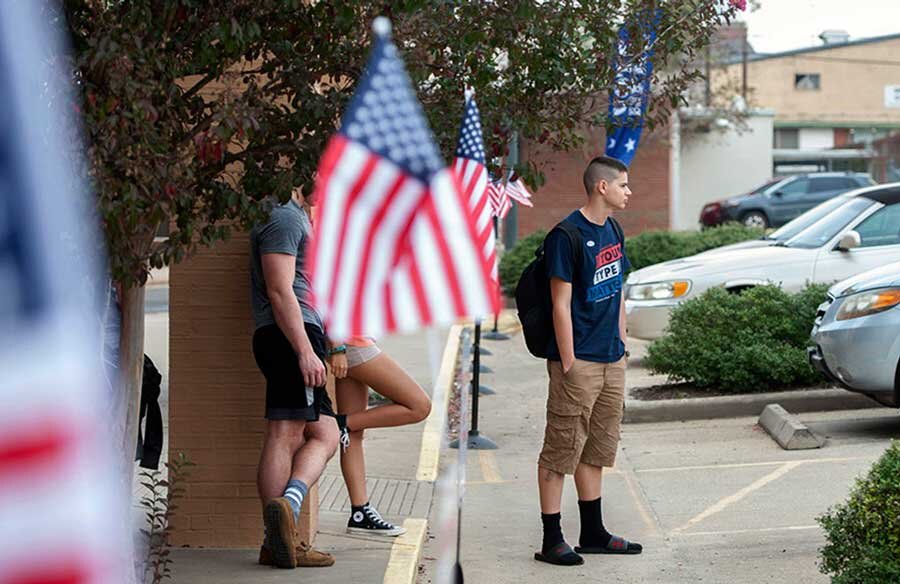Teaching civics in an age of Trump
Loading...
When some of Nathan McAlister’s middle school history students claimed President-elect Donald Trump was going to repeal Obamacare on his first day in office, he used it as a teaching moment about the checks and balances of US government.
He did the same when others said Hillary Clinton would take away everybody’s guns if she won.
As Mr. McAlister watches the protests over Mr. Trump’s election unfold on television, he muses on the current level of civic knowledge among young people across the political spectrum.
“We've lost, I would say, 10 to 15 years of good civic education and historical thinking skills for students – it's almost like we've turned our president into a monarch,” he says. “Think about it: They assume the president has all this power, and that's just not reality.”
But as the nation continues to feel the aftershocks of a tumultuous election, McAlister is teaching his class of mostly rural conservative white students and Native American students at Royal Valley Middle School in Mayetta, Kan., to overcome the ignorance and incivility that some see as partly responsible for the tenor of the campaign.
Like McAlister, some teachers are using Trump’s election to reawaken Americans across the political spectrum to how vital civic knowledge and skills are for making government truly by the people, for the people. Efforts range from a multi-state push to make high-school students pass a civics quiz before they receive their diplomas to online gaming platforms that explain to students their rights as citizens.
“This is a better opportunity than ever to really build that kind of citizenship,” says Kei Kawashima-Ginsberg, director of the Center for Information and Research on Civic Learning and Engagement (CIRCLE), a leading organization on youth civic education at Tufts University in Medford, Mass. “If the government isn't the one driving the process … then the people need … to have the skills to engage – we really need to recalibrate civic education in ways that we haven't before.”
McAlister’s efforts are all about getting kids to take on roles that echo real life. One week, they might be drafting legislation targeting real local problems. Another, using an online platform, iCivics – a nonpartisan series of games that walk children through everything from their citizen rights to running for president. It’s a way to get kids motivated to explore a central, but often neglected issue: How their country works, and how they can engage the mechanisms for change.
But it’s often not done this way. The number of American students being exposed to the kind of rich civics experience McAlister offers are a small minority peppered across the nation, experts say. Over the past 30 years, a federal focus on standardized testing to lift math and literacy rates has progressively squeezed civic education out of mainstream curriculums. With school funding partly tied to performance on STEM and language arts tests, and parents touchy about how certain events are covered, many teachers aren’t eager to engage with civics lessons.
But there is a cost: Data show these developments are paralleled by weak civic knowledge and civil political participation among the young. An estimated 50 percent of young voters (age 18 to 29), around 24 million, showed up at the polls Nov. 8 – slightly below the all-time high of 52 percent in 1972, the year 18-year-olds got the vote. By contrast, 72 percent of voters over 65 and 68 percent of voters between ages 45 to 64 voted in 2012, according to the Census.
In 2014, only 23 percent of US students scored as “proficient” in civics, according to the National Assessment of Educational Progress. Those numbers are particularly low among African American and Latino students, who tested proficient at nine percent and 12 percent respectively.
Ms. Kawashima-Ginsberg says such gaps in civics education can lead many young voters to feel disenfranchised, believing democracy is all theory and doesn’t apply to them.
“We need to stop thinking of civic engagement as voting," she says. "I do think as a field and as a public we do a pretty poor job of really communicating that citizenship includes so much more than that. It's really about how we live together.”
Social studies teacher Jessica Lander folded an action civics curriculum by Generation Citizen into her 11th and 12th grade English language learner US history classes. It requires students to choose a real-life local issue and decide how to solve it – together.
Last year, one of her internationally diverse 12th grade classes at Lowell Public High School in Massachusetts decided to focus on reducing Islamophobia on campus after a number of the school’s Muslim students were bullied. Students had to agree on the problem they were to tackle, work out its root cause – not enough education about what Islam is – do the research to educate themselves, and create a plan for solving it.
Carla Duran, a student from the Dominican Republic, took Ms. Lander’s class before graduating last year. She and her peers broke into groups that got to work on the cause: some collected data on Islamophobia in the school, some talked with school leadership, others designed posters that will go up in the spring.
“So for me, at the beginning with all this news talking about the Muslims, that they're terrorists and all that stuff, I was afraid at one point. But after I had to work with the situation, what is the real problem … my path changed,” says Ms. Duran.
Before the class, she described herself as politically passive. But she loved the class so much she has returned as a teacher’s aide and is encouraging those at her community college to become politically active.
Many students don’t get such an opportunity because parents and teachers alike are worried about political blowback. In some states, attempts to make some civics mandatory have been shot down.
“Often teachers are scared of parents,” says John Broome, an assistant professor of education at the University of Mary Washington in Fredericksburg, Va., whose dissertation focused on adolescent civic learning. “Teaching anything, teaching social studies, civics or not, is political.”
That said, civics has become something of a bipartisan issue. Fourteen states, mostly GOP-led, have adopted a mandatory 100-question civics graduation test with questions drawn from the US citizenship test, according to the conservative Joe Foss Institute’s Civic Education Initiative, whose goal is to have all 50 adopt the test by the 230th anniversary of the Constitution in 2017.
Kawashima-Ginsberg prefers the action civics model over yet another test, but says such models can be adapted in a way that’s sensitive to conservative values.
“It's actually very libertarian in some ways, we're talking about local citizens acting on local issues, not involving federal government at all,” she says.







